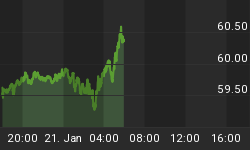According to Dow theory, the Secondary Trend remains positive. Furthermore, nothing has occurred at this time to reverse this positive development. Understand, Dow theory deals with price action, while the market internals allow us to look at the underlying strength or weakness associated with a given trend of a given degree. Today, I want to look at the intermediate-term and what the Advance/Decline data is showing us.
Below is a daily chart of the Dow Jones Industrial Average. I have labeled the last three intermediate-term lows with an "I." In Dow theory terminology, these are "Secondary Reaction" lows and of course the highs that follow are "Secondary Reaction" highs. In cyclical terms these are 22-week cycle tops and bottoms. Nonetheless, the movement is one of the same regardless of the label we put on it. The green line in the upper window of this chart is a measure of NYSE advancing issues that I have tied or timed to ebb and flow with this intermediate term 22-week cycle. The red line is of declining issues.

Notice that in the early stages of the move up into these intermediate term price advances, the advancing issues expand. As the intermediate term move matures, the advancers begin to lag and the decliners begin to expand as the secondary advance rolls back over into the next intermediate term low. From Martin J. Pring's book, Technical Analysis Explained, he writes "Breadth indictors measure the degree to which the vast majority of issues are participating in a market move. They therefore monitor the extent of a market trend. Generally speaking, the fewer the number of issues that are moving in the direction of the major averages, the greater the probability of an imminent reversal in trend." This is exactly what happens as these 22-week cycle advances mature and this is visible by the green advancing issues line. So, here we sit with the Secondary Trend positive, but the underlying NYSE breadth of the market is beginning to falter.
Next, I have plotted the same chart of the Industrials, but I have included the Advance Decline data for the American Stock Exchange. I have included this data because I know many question the integrity of the NYSE data given the preferred and interest related issues that have been added to the NYSE. Nevertheless, it is interesting to note that we see the exact same behavior with this breadth data and it has not been contaminated.

But wait, what about the Nasdaq? Well, below I have included a chart of the Nasdaq 100, with the Nasdaq Advance Decline data in the window above. Here too, the same phenomenon occurs time and time again. As the secondary reaction moves up and matures, it becomes tired. The internals begin to fade and the market rolls over. In effect, the market runs out of fuel. It is this ebbing and flowing that creates this natural cyclical rhythm of the market.

The bottom line is that yes, the Secondary Trend is positive. But, with deteriorating internals this Secondary advance is obviously beginning to get just a bit tired.
Cycles News & Views offers information on the technical aspects of the market using historical trend quantification, Dow theory, cycles and internal measures such as this. I have also developed my unique intermediate-term Cycle Turn Indicator to help us identify and confirm important turn points in the market. For more information, please visit www.cyclesman.com.
















